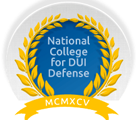NHTSA Standardized Field Sobriety Tests
The Standardized Field Sobriety Tests (SFST's) were created by The National Highway Traffic and Safety Administration (NHTSA) as guidelines to assist law enforcement officers when investigating whether a driver is possibly intoxicated. If a driver is pulled over for a routine traffic violation and the driver is suspected to have been impaired, the SFST's may be conducted.
The SFST's consist of 3 different tests, usually conducted in this order:
1. Horizontal Gaze Nystagmus Test
2. Walk and Turn (WAT) Test
3. One-Leg Stand (OLS) Test
The arresting officer should be trained to follow the required NHTSA protocol when administering the tests. The arresting officers should give proper instructions and demonstration before the driver is asked to perform. Very often the arresting officers do not follow the required procedure. Often the HGN is conducted incorrectly and in violation of how NHTSA indicates it should be tested. As well, often instructions for the WAT and OLS are not clearly communicated, or they are given out of order. NHTSA very cleary states that if any of the elements are deviated or are changed in anyway, the results are COMPROMISED.
IT IS NECESSARY TO EMPHASIZE THIS VALIDATION APPLIES ONLY WHEN:
- THE TESTS ARE ADMINISTERED IN THE PRESCRIBED, STANDARDIZED MANNER.
- THE STANDARDIZATION CLUES ARE USED TO ASSESS THE SUSPECT’S PERFORMANCE.
- THE STANDARDIZATION CRITERIA ARE EMPLOYED TO INTERPRET THAT PERFORMANCE.
IF ANY ONE OF THE STANDARDIZED FIELD SOBRIETY TEST ELEMENTS IS CHANGED, THE VALIDITY IS COMPROMISED. (NHSTA MANUAL R2/00 VII-3; R1/02 VIII-19; R9/04 VIII-19; R2/06 VIII-19)
Horizontal Gaze Nystagmus
The Horizontal Gaze Nystagmus (HGN) Test is designed to measure whether there Nystagmus is present in the eye. Nystagmus is the involuntary jerking of the eyes at a certain angle, off to the side. While under certain conditions, most particularly if done in a laboratory setting with proplerly trained medical personnel, the HGN can be something that could be a somewhat helpful tool to help determine whether a person has consumed alcohol. The most troubling aspect of the HGN is that it is rarely performed correctly. As well, it is almost always done on the side of the road and at night, usually tested with the tip of a pen or with the tip of a finger of the investigating officer.
It is widely accepted, including stating as such in the NHTSA manual itself, that there are many possible reasons for a person showing signs of Nystagmus. There are 47 types of Nystagmus in individuals, separate from Horizontal Gaze Nystagmus, and over 38 different causes. Given this, it is startling for most people to realize that the officer is only trained to detect one.
There are at least 47 different types of Nystagmus, separate from Horizontal Gaze Nystagmus, including:
(1) Acquired; (2) Anticipatory (induced); (3) Arthrokinetic (induced, somatosensory); (4) Associated (induced, Stransky’s); (5) Audio kinetic (induced); (6) Bartel’s (induced); (7) Brun’s; (8) Centripetal; (9) Cervical (neck torsion, vestibular-basilar artery insufficiency); (10) Circular/Elliptic/Oblique (alternating windmill, circumduction, diagonal, elliptic, gyratory, oblique, radiary); (11) Congenital (fixation, hereditary); (12) Convergence; (13) Convergence-evoked; (14) Dissociated (disjunctive); (15) Downbeat; (16) Drug-induced (barbituate, bow tie, induced); (17) Epileptic (ictal); (18) Flash induced; (19) Gaze-evoked (deviational, gaze-paretic, neurasthenic, seducible, setting-in); (20) Horizontal; (21) Induced (provoked); (22) Intermittent Vertical; (23) Jerk; (24) Latent/Manifest Latent (monocular fixation, unimacular); (25) Lateral Medullary; (26) Lid; (27) Miner’s (occupational); (28) Muscle-Paretic (myasthenic); (29) Optokinetic (induced, optomotor, panoramic, railway, sigma); (30) Optokinetic After-Induced (post-optokinetic, reverse post-optokinetic); (31) Pendular (talantropia); (32) Periodic/Aperiodic Alternating; (33) Physiologic (end-point, fatigue); (34) Pursuit After-induced; (35) Pursuit Defect; (36) Pseudo spontaneous; (37) Rebound; (38) Reflex (Baer’s); (39) See-Saw; (40) Somatosensory; (41) Spontaneous; (42) Stepping Around; (43) Torsional; (44) Uniocular; (45) Upbeat; (46) Vertical; (47) Vestibular (ageotropic, geotro-pic, Bechterew’s, caloric, compensatory, electrical/faradic/gal vanic, labyrinthine, pneumatic/compression, positional/alcohol, pseudo caloric.
Compounded by this, it has been shown that there are over 38 different causes of Nystagmus, as judicially recognized in Schultz v. State, 664 A.2d 60, 62 (Md. Ct. Spec. App. 1995).
In Shultz, the Court court found that the HGN test was a scientific test and that the test was generally reliable. However, in this particular case, the officer was not properly trained as an expert and his testimony was therefore inadmissible. The court reasoned that when the HGN test is not performed correctly, the results are not reliable.
Schultz v. State recognizes that there are at least 38 other causes of nystagmus including:
(1) problems with the inner ear labyrinth; (2) irrigating the ears with warm or cold water under peculiar weather conditions; (3) influenza; (4) streptococcus infection; (5) vertigo; (6) measles; (7) syphilis; (8) arterioscle¬rosis; (9) muscular dystrophy; (10) multiple sclerosis; (11) Korchaff's syndrome; (12) brain hemorrhage; (13) epilepsy; (14) hypertension; (15) motion sickness; (16) sunstroke; (17) eye strain; (18) eye muscle fatigue; (19) glaucoma; (20) changes in atmospheric pressure; (21) consumption of excessive amounts of caffeine; (22) excessive exposure to nicotine; (23) aspirin; (24) circadian rhythms; (25) acute trauma to the head; (26) chronic trauma to the head; (27) some prescription drugs, tranquilizers, pain medications, anti-convulsants; (28) barbiturates; (29) disorders of the vestibular apparatus and brain stem; (30) cerebellum dysfunction; (31) heredity; (32) diet; (33) toxins; (34) exposure to solvents, PCBS, dry cleaning fumes, carbon monoxide; (34) extreme chilling; (35) eye muscle imbalance; (36) lesions; (37) continuous movement of the visual field past the eyes, i.e.,looking from a moving train; (38) antihistamine use.
Walk and Turn
The Walk and Turn (WAT) Test is a divided-attention test, meaning it is designed to detect both mental and physical impairment. Prosecutors will generally try to argue that any variation between the way the officer explained and demonstrated the WAT Test, and the manner in which the driver performed the test, is proof of mental and/or physical impairment.
The investigating officer usually administers the WAT Test in two parts – first by directing the driver to stand heel-to-toe, arms down, while listening to instructions on how to perform the test. The officer then instructs the driver to take nine heel-to-toe steps along a real or imaginary line, turn, and take nine heel-to-toe steps back toward the officer. While the driver performs the test, the officer watches for any signs that the driver is impaired.
The eight signs that the officer looks for are:
1) Inability to balance during instructions;
2) Starting the test too soon;
3) Stopping while walking;
4) Inability to touch heel to toe;
5) Stepping off of the line;
6) Using his or her arms to balance;
7) Loss of balance during the turn or inability to turn correctly;
8) Taking the incorrect number of steps.
If the officer notices two or more of these "clues", they likely will conclude that the driver is legally too intoxicated to operate a motor vehicle. However, many of the "clues" noted in the WAT Test can be caused by physical conditions attributed to other factors aside from alcohol, such as injury, fatigue, or illness. This test is especially unsuitable for people with back or leg injuries, individuals older than 65, those over 50 pounds overweight, and those with inner-ear disorders. A driver who takes the test on an unlevel surface, or an individual wearing shoes with heels higher than two inches also may not perform well on the WAT Test. As well, often the investigationg officers do not administer the WAT Test properly, or they do not interpret the results the way they should.
One-Leg Stand
The One-Leg Stand (OLS) Test is usually conducted following the Walk and Turn Test. Like the WAT Test, the surface where the test is performed should be hard, dry, and non-slippery. Also, the surrounding area should not be one that endangers the driver if they were to fall while performing the test. If the investigation occurs at night, the area should be illuminated. The reasons for this are obvious, in that even those individuals who have not consumed any alcohol would have difficulty balancing in total darkness.
The police officer should observe the driver's performance from a distance, at least three feet away, so as to not distract the test subject. The officer should inquire to the driver whether they have any past injuries they may hamper the individual’s ability to perform the test. As with the WAT Test, injuries can render the test inaccurate and unreliable. If, for example, one leg has been injured in the past, the investigating officer should inform the driver to use the opposite leg. As well, if the person is wearing high heels or shoes with heels that are two inches or taller, they should be allowed to take off the shoes and perform the test barefoot.
Whether the driver passes the OLS is determined by a scoring system outlined in the NHTSA manual. The score is based on four components. The investigating officer will count a "clue" against the driver for each seen in the performance of the test. The officer looks for the following "clues":
1) Sways while balancing;
2) Uses arms for balance;
3) Hops;
4) Puts foot down.
Like with the WAT Test, there are many reasons for why one would not perform well on the OLS Test. The OLS is a test many people would fail even if they had not consumed any alcohol whatsoever. Officers are taught this during their training at the academy, but usually refuse to acknowledge this when questioned in court. People who are 60 years of age or older often have poor balance and will perform poorly on this test. Likewise, people who are 50 pounds or more overweight could fail the test due to having poor balance or a lack of coordination. Like with the WAT Test, injuries, medical conditions, and fatigue can all affect how well someone balances while standing on one leg. Because most DWI investigations occur at night, darkness can also be a factor. The investigating officer should have been trained to shine their flashlight on the ground near the driver's feet for illumination, but often this bright light will jiggle and disorient the test subject.
Do You Have To Take The SFST's If Pulled Over?
There is absolutely no legal requirement for you to take these tests. The reason the police officer requests you perform these tests is almost always because they believe you to be intoxicated. If this is their primary objective, they are merely trying to gather evidence to try and secure a conviction against you in court! Often there are alternate reasons for why a person may not be a candidate for the SFST's. There are many other reasons aside from intoxication that may render a person unable to perform optimally on the SFST's, including fatigue, nervousness, physical disabilities, road or street conditions, environmental conditions, wind, weather, inadequate footwear, weight, and age.
What Do I Do If They Asked To Perform The SFST's?
If a police officer pulls you over and requests that you submit to performing the SFST's, politely ask to speak to your attorney, Carl David Ceder, at 214.702.CARL (2275). Politely refuse to the taking of the test, and try to do your best to remain calm. If you refuse to submit to performing the SFST's, you are likely going to jail. Call The Law Offices of Carl David Ceder, PLLC, as quickly as possible and Carl will try and help facilitate a fast and speedy release.
Are the SFST's Reliable?
Dr. Lance Platt, a renowned expert and SFST instructor conducted an extensive study on how well arresting police officers administered the tests when investigating a possible imparied motorist. Dr. Platt evidently reviewed thousands of actual videos of police officers testing accused drivers throughout the course of his analysis to track how accurate the NHTSA protocol is followed. Dr. Platt concluded that 97% of the time the investigating officer incorrectly administered at least one of the three Standardized Field Sobriety Tests. Based on Dr. Platt's study it is easy to understand how incorrect administration of the SFST's can very easily lead to false-positive results.
Even if the SFST's are administered correctly, they still can lead to gross inaccuracies because the foundation with which they are based is built around faulty assumptions that vary with any individual. The basic premise of the SFST's is that if the driver is not impaired, they should be coordinated enough to pass the tests. This assumption is faulty because there are many alternate reasons for a person may not perform well, such as:
- Stress
- Fear of the police
- Nervousness
- Confusion Due to Unfamiliar Circumstances
- Illness
- Fatigue
- Prescription Medication
In summary, many experts in the field believe the Standardized Field Sobriety Tests should just be used as a screening tool, and not as a final, and ultimate conclusion as to whether someone is intoxicated. The performance on SFST's can be skewed for a variety of reasons, and should be evaluated on a case by case basis. If you our someone you know has been accused of a Driving While Intoxicated Charge (DWI) anywhere in Texas, then please call 214.702.CARL (2275) now to speak to a highly trained, and experienced DWI Defense Attorney.






















